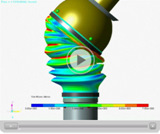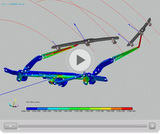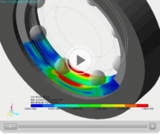RECURDYN MENU
RecurDyn/FFlex
RecurDyn/FFlex (Full Flex) lets you combine the power of Finite Element Analysis (FEA) and Multibody Dynamics (MBD) to increase the accuracy of your simulations. With RecurDyn/FFlex, you can define a flexible body by importing an FEA mesh. RecurDyn/FFlex provides the most benefit in situations where flexible bodies are in contact with other bodies, or where the effects of nonlinear deformation on system performance need to be assessed.
RecurDyn was used to evaluate the performance of a compliant clutch mechanism. As the rotational speed of the clutch increases, centrifugal force pulls the flexible clutch plate outwards so that it contacts the outer ring. The outer ring slowly begins to turn as the flexible clutch plate tranfers power to it through friction. The contour plot of Von Mises stress shows the areas of highest stress to be the “flex points” and the areas of contact with the outer ring.
Benefits
- RecurDyn/FFlex uses the original FE mesh without any assumptions or restrictions
- Accurately represents sliding or continuous contact along a flexible body (not possible with modal techniques).
- Represents flexible bodies with a local or large deformable system, including nonlinear deformation.
- Easy to obtain an accurate and reliable solution because RecurDyn/FFlex does not requires the pre-analysis of FE data nor the know-how of classic FE dynamics.
Features
- Nodal Flexible Body Editing – A Nodal Flexible Body includes FE information and may be a complicated system on its own. For that reason it may be complicated to create or modify. The Body Edit Mode makes it easy to create and modify the Nodal Flexible Body. With the Body Edit Mode, you can do the tasks described below.
- Create and modify Material and Property data
- Modify the basic information of Nodes and Elements
- Easily model with the Set and Component commands
- Identify the node and element ID with the Change ID function
- Define Boundary conditions
- Define Output nodes
- Upgrade the graphic performance using the Display option
- Contact with the Nodal Flexible Body – One of the best features of Nodal Flex is the ability to solve for local deformation due to a contact force. You can describe various contact types as listed below.
- Flexible surface to flexible surface
- Flexible surface to rigid surface
- Flexible surface to rigid sphere
- Flexible surface to flexible curve
- Flexible curve to flexible curve
- Flexible curve to rigid surface
- Flexible curve to rigid sphere
- Specialized Post-Processing – Special outputs help the user understand the rich set of data that is output for the many Nodal Flexible Body entities. The data is too extensive to review by plotting.
- Color contours can be displayed on the surface of a Nodal Flexible Surface to indicate relative displacement, strain, and stress.
- The scope function can be used to see the output of nodes of interest.
- Uses FE mesh definitions from various FEA software:
- ANSYS
- Siemens NX Nastran
- MSC/Nastran
Additional Example Applications
 RecurDyn Simulation of CV Joint Boot (Flexible Body Self Contact)
RecurDyn Simulation of CV Joint Boot (Flexible Body Self Contact)
In this Automotive Case Study, RecurDyn/FFlex (Full Flex) was used to model the flexible boot of a Constant Velocity (CV) joint. The simulations were validated by the behavior of the existing design and were used to achieve improved performance in the new design.
More Information
- Request more information about this and other software modules.


